 |
Hempstead |
|
Families |
|||||
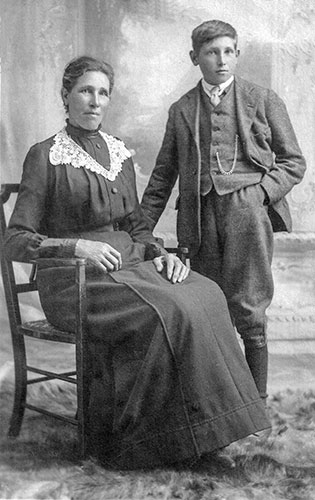 |
Sarah Ann Dagless (Long Sal) with one of her sons
at a studio in Sheringham - c.1912 |
Sarah Ann Dagless or Long Sal, as she became known, due to being very tall (unproven rumour of 6ft 2ins) became somewhat of a legend thanks to the account of her time at Smokers Hole in Hempstead, along with her voiciferous dog and belligerent pony, as related by Jane Hales in 1971. |
Sarah Ann's mother, Emily Rice was the 7th child of Edmund Rice (b.1811) and Sarah (née Land) (b.1814) |
Sarah Ann's mother Emily Hubbard (née Rice) (1850-c.May 1933) was born at Rackheath/Coltishall/Horstead (as enumerated in various census listings). She gave birth to Sarah Ann on 31st October 1868 after a liaison with Thomas Hollit, it is thus believed she was probably illegitimate. The only record of Thomas Hollit found so far, is his listing as Sarah's father on her marriage certificate and only her mother's name appears on Sarah's baptism record. |
Emily and Thomas Hubbard had 8 children - |
| 9th April 1848: Thomas Hubbard christened at Woodbastwick The 1861 census records Emily Rice (aged 10) living at Salhouse
|

|

|
On 23rd December 1894, Sarah's half brother, Thomas William Hubbard was killed at Briston, when he was struck by train on the Midland & Gt Northern Railway. Thomas was 24 years old. |
|
In 1881, Sarah was living with Thomas, her mother Emily and family in Catfield. At some point in the next 9 years, the family moved to Briston. |
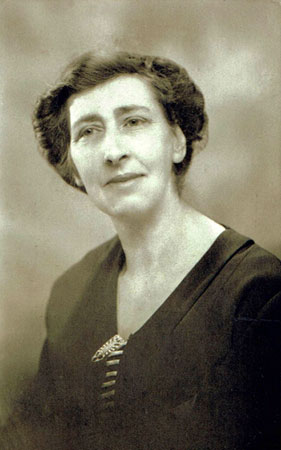 |
Emily May Hubbard known as 'May' |
Sarah had a younger sister, (Emily) May (1890-1966), who according to the back of the above photograph was described as being a rum 'un. May was born and baptized in Briston. She married Arthur Chilton (b.1887) and moved to Middlesex. |
On 21st November 1859, William Dagless (b.Saxthorpe 1838 - d.Edgefield 18th January 1918) married |
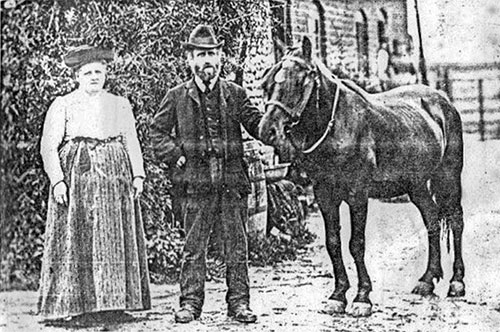 |
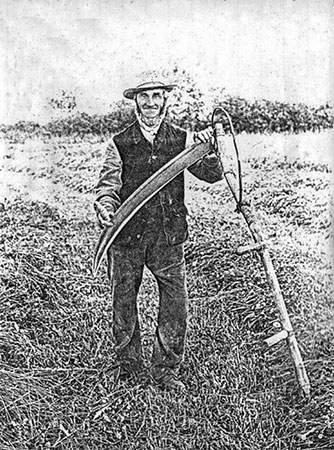 |
Charles Dagless (brother of William Dagless) 1856-1941 married Esther Ann Williamson b.1861 on 14th February 1878 Charles Dagless farmed at Dotsel, Edgefield - c.1915 |
William Dagless (father of James Dagless) farmed at Valley Farm, Edgefield - c.1900 |
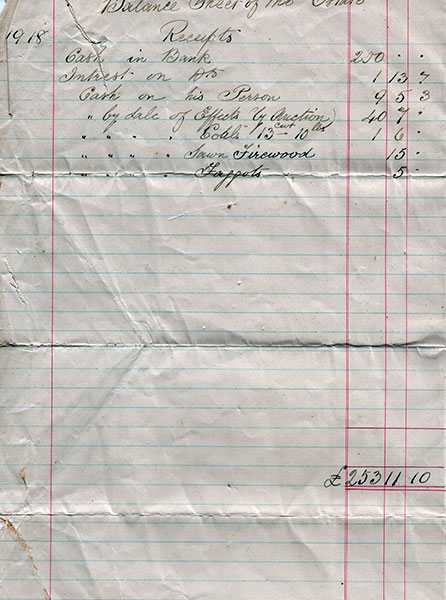 |
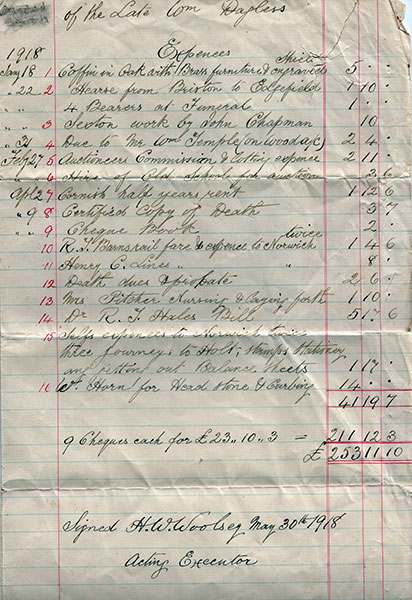 |
William Dagless' final receipts - 1918 |
William Dagless' funeral expenses and final accounts - 1918 |
Sarah Hubbard worked as a midwife who attended women in their own homes. |
Sarah Ann Hubbard (Long Sal) met James Dagless in Saxthorpe through her work as a midwife and after James' wife Harriet (née Chapman 1858-1893) died, Sarah moved to Edgefield to become James' housekeeper. |
James Dagless and his first wife Harriet (née Chapman, Edgefield 1858-1893) had 6 daughters - |
The records for my husband's family tree show Long Sal's birth name to be Sarah Ann Rice (1868 - 1956) born in Salhouse. I have now found the marriage banns and the marriage of Sarah Ann Rice to James Dagless on Ancestry. |
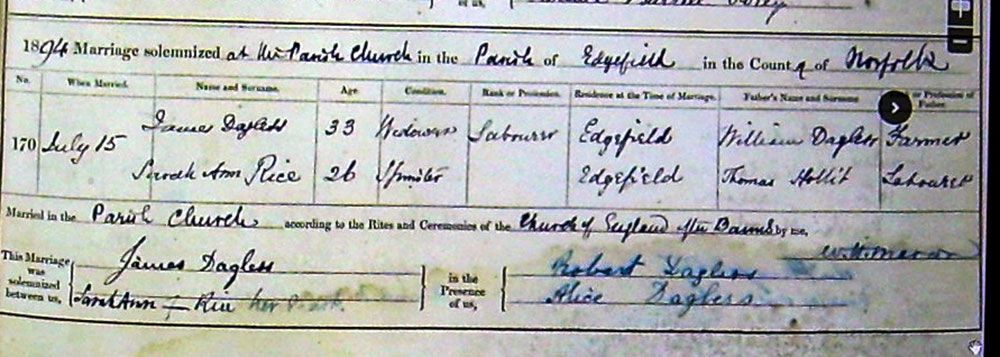 |
Sarah Ann Rice (Long Sal) and James Dagless' Marriage Certificate - 15th July 1894 |
James Dagless was Christened in Saxthorpe on 24th February 1861 and had 13 siblings
|

Register of Electors 1887: James Dagless, Farm house, private road to street, Edgefield Register of Electors 1889: James Dagless, Near Norwich road, Edgefield Register of Electors 1895: James Dagless, Chapel Hill, Edgefield Register of Electors 1897: James Dagless, Chapel Hill, Edgefield Register of Electors 1899: James Dagless, Chapel Street, Edgefield Register of Electors 1900: James Dagless, Chapel Street, Edgefield
|

|
Register of Electors 1904: James Dagless, Chapel hill from Barningham road, Edgefield Register of Electors 1905: James Dagless, Chapel Hill, Edgefield Register of Electors 1907: James Dagless, Chapel Hill, Edgefield Register of Electors 1908: James Dagless, Chapel Hill, Edgefield Register of Electors 1909: James Dagless, Chapel Hill, Edgefield
|
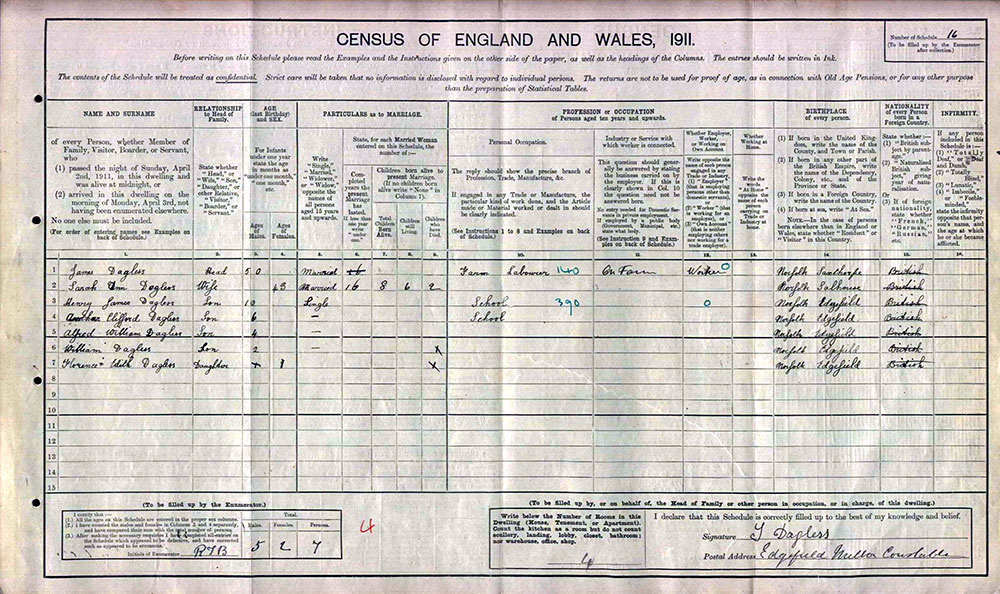
Register of Electors 1912: James Dagless, Ramsgate Street, Edgefield |
Sarah Ann and James Dagless went on to have 8 children - |
Little is currently known of Sarah's and James life between 1914 when they were living in Edgefield and when they moved to one of the two cottages at Smokers Hole in Hempstead, where they certainly were in the 1930s. |
Hempstead_Hall_watermill is one of the lost mills of Norfolk and has completely disappeared except for some traces of brickwork. However, it was once there in a place known as Smokers_Hole, a smugglers' haunt and the two semi-detached single storey cottages next to it were called Mill Cottages. Sadly, the cottages have also disappeared save for some low walls of brick and flintwork. Earlier maps show the cottages as Mill House, which was split into two cottages at a later date. |
Smokers_Hole, according to local historian Jane Hales, referred to a depot or rendezvous used by smugglers in the process of moving their contraband inland as fast as possible. In William Newman's book of 1728, three buildings are shown on the site, one of which could well have been a barn. |
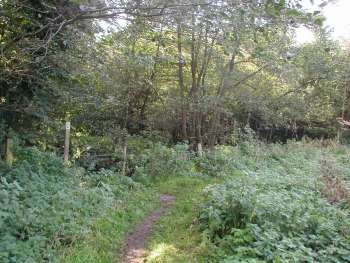 |
Track to the Mill cottages - 29th September 2002 |
|
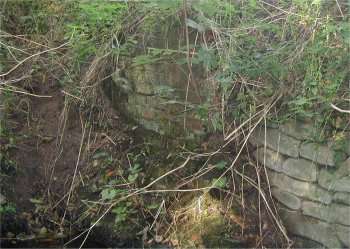 |
29th September 2002 |
The old brickworkof the mill is on the left |
During the early years of the war, the army used the area for practicing working with incendiary bombs and the site became unsafe due unexploded devices, one of which was found in 2008. After the war the cottages gradually became derelict and eventually collapsed. |
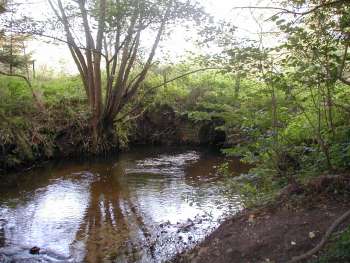 |
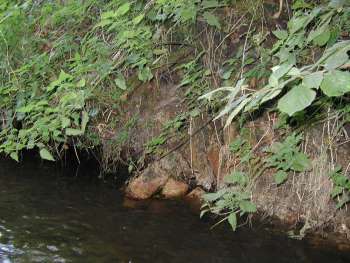 |
29th September 2002 |
More old brickwork on the nearside bank |
Good Friday Then Sarah the little one nursing the baby so good Jenny has just reminded me to say |
My mother mentioned I did not list Sarah and James' other children; Henry James born 1899, Arthur Clifford born 1904, Alfred William born 1907, William born 1909. I think William was the 'lovely little boy' my grandmother used to speak of who died as an infant. There seems to be a Florence Edith born 1910 and I'm wondering if the same thing happened with her as we had never heard of my grandmother having any full sisters. |
'Long Sal' of Jane Hales fame was my father's maternal grandmother. Her name was Sarah Dagless, née Rice. She was married to James Dagless. We do not know quite when they moved from Edgefield to live in one of the Smokers' Hole cottages. My father often described the Sunday afternoon family visits there which took place when he was a child in the thirties. |
My husband's grandmother was born Emily Mary Dagless in Erpingham (1895 - 1982) her mother was Sarah Ann Rice (1868 - 1956) she married James Dagless from Saxthorpe. My husband can remember his great-grandmother as being very tall. |
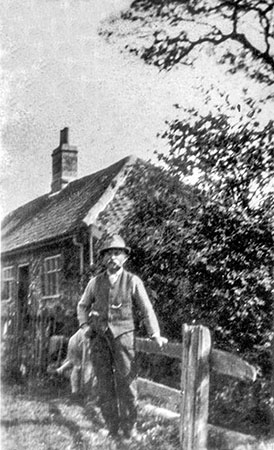 |
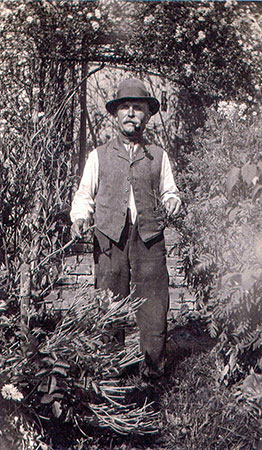 |
James Dagless outside the Mill Cottages at Smokers Hole - c.1932 |
James Dagless in the garden of Walter and Emily Smith's larger house in Baconsthorpe - c.1937 |
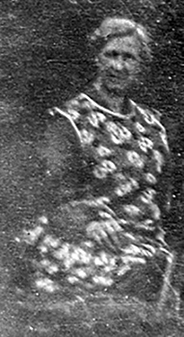 |
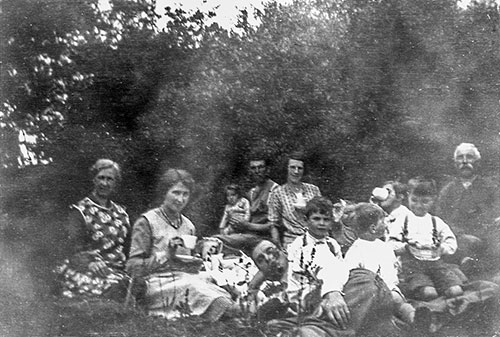 |
Sarah Ann Dagless (Long Sal) c.1932 |
Picnic near Smokers Hole - c.1932 Front left to right - Sarah Dagless, Emily Smith (daughter), Walter Smith (husband) Frederick Smith (their son), Henry, Peter (b.1928), James Dagless - far right Family at the back - unknown |
My late Granny, May Ellis lived nearby at Valley Farm. I was always told Long Sally was very tall and regularly drove her horse and cart along the lane (now a muddy path) up to the Norwich Road. Her house at Smokers Hole got taken over by the army in WWII and was used for target practice. |
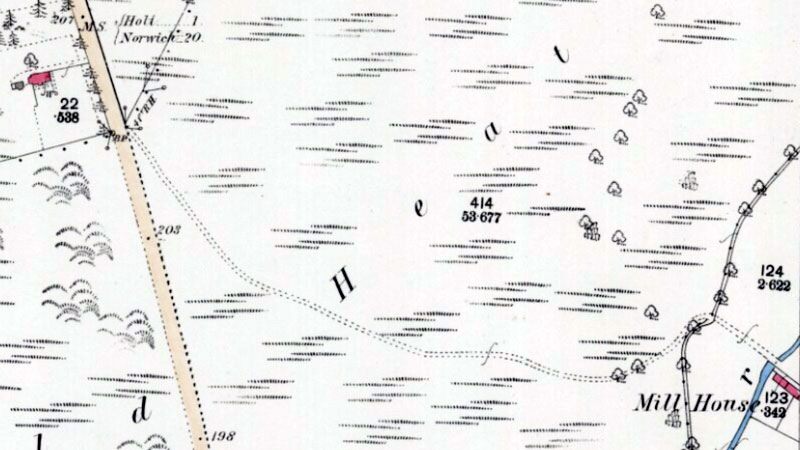 |
O. S. Map 1885 showing the track leading from Smokers Hole, (Mill House) up the steep hill to the Holt - Norwich Road Courtesy of NLS map images |
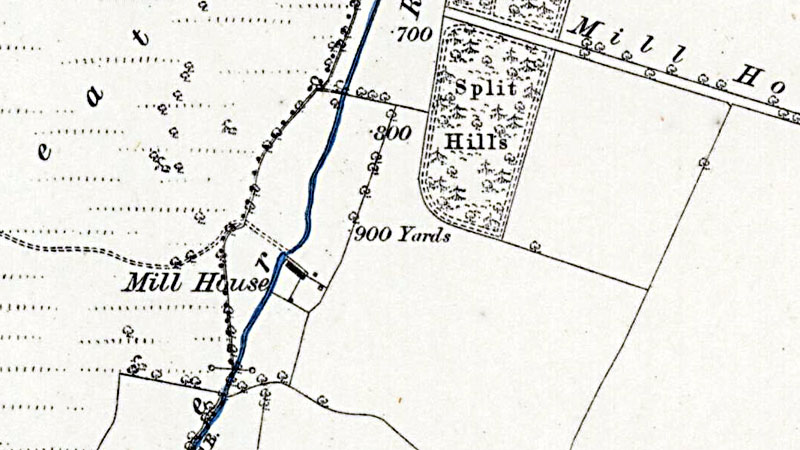 |
O. S. Map 1886 Mill House Lane leading from Hempstead Hall to the mill The section of track running through the woods had a steep incline The original course of the Glaven following the parish boundary can be seen to the west of the present and straighter course Courtesy of NLS map images |
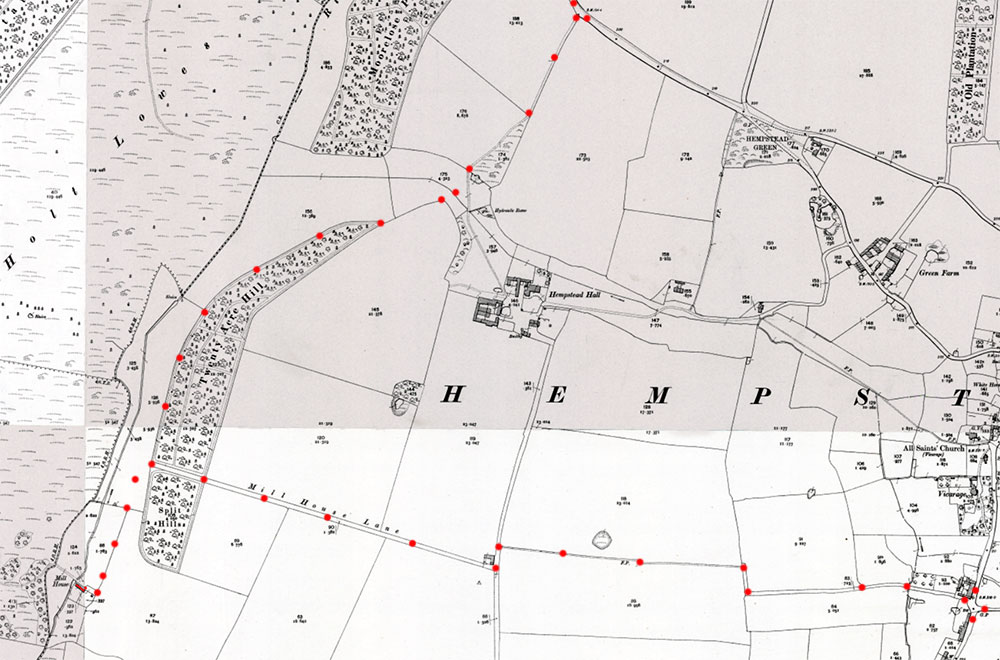 |
O. S. Map 1905 showing the tracks leading from Smokers Hole, up to the Baconsthorpe Road and also across to Hempstead village Courtesy of NLS map images |
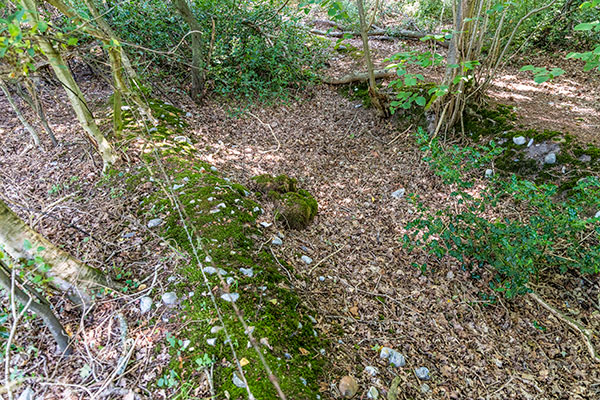 |
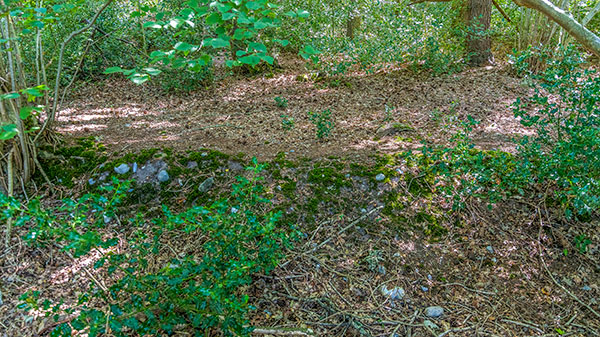 |
The track wall with the later barbed wire fence line is in the foreground with the paved track running parallel and a drainage area between - 3rd August 2020 |
The substantial track cut into the hill clearly visible - 3rd August 2020 |
In order to access Hempstead Hall Farm, which probably supplied the mill with corn, nother track was constructed that cut through the hill leaving a small southern hill area that became known as Split Hills. The track through what is now the wooded area is steep and any horse with a cart would have had a difficult time in either direction. Once up the hill and onto Mill House Lane, the track immediately levelled out before going down the more gentle slope to the Hall. |
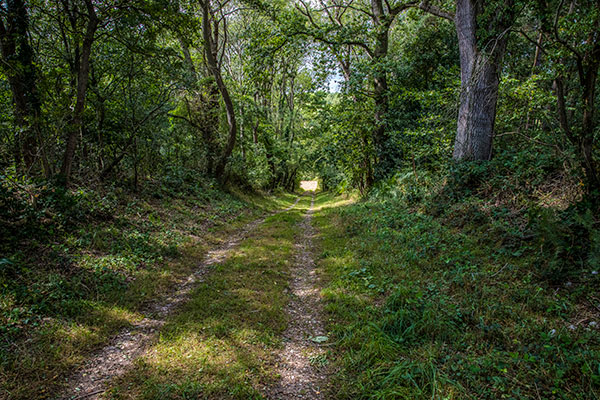 |
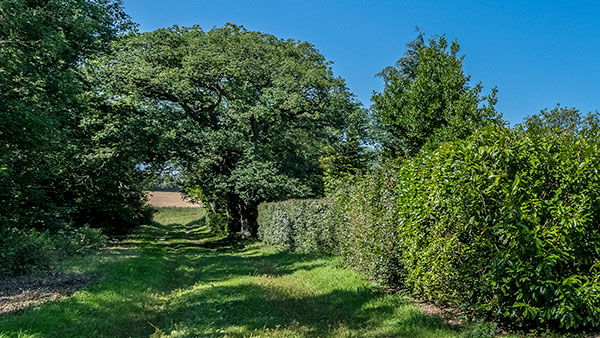 |
Mill House Lane running through the wood just above and looking towards Smokers Hole track 22nd August 2020 |
Clamp Lane running beside Church Farm, looking towards Smokers Hole - 31st July 2020 |
It is the Selbrigg_Pond that is the main source of the Glaven. It was made as a decoy in the opening years of the last century. Nearby, the great Hempstead woods were felled in the last war, and replanted by the Forestry Commission with dark conifers. They stretch along the Glaven valley to the first_mill by the Hempstead-Holt road. Below the mill, the stream flows through wet meadows, the boundary between Hempstead and Holt, to Smokers Hole, where there are the ruins of another very old mill house. In it lived Long Sall, all alone. She had to leave during the war because the explosions, made by the soldiers on the adjoining common of Holt Lows, threatened to tumble down her house. |
Less than a mile and a half from the busy little town, which is thronged with people from the villages on a Saturday afternoon, and the sides of the Street are stiff with cars, is that secluded spot called Smokers Hole. Once there were two ways of approach - down the common land, by a bridge over the stream, or by a well-worn path, in a fold of heath, leading off the main Norwich road. Both paths brought one to the long meadow, sheltered on the north by the slopes of the Common, and on the south by rising woods and fields. Here was a cottage by the bridge. ln it lived a family of children, but the meadow was also a playground for many from the town. It was not strictly public property, but nobody was turned off. Men went there fishing, some tickled trout, children paddled or even bathed by the bridge. Boys from the Grammar School blocked the flow of the stream, and increased the depth, for their steeplchases. |
Henry James Dagless joined the army and served overseas in the Norfolk Regiment. |
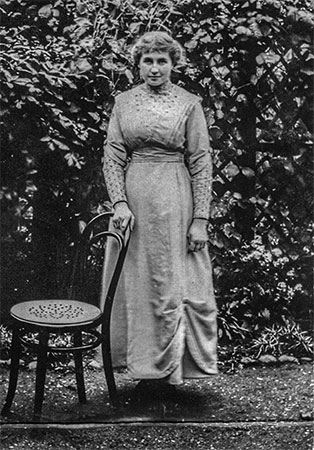 |
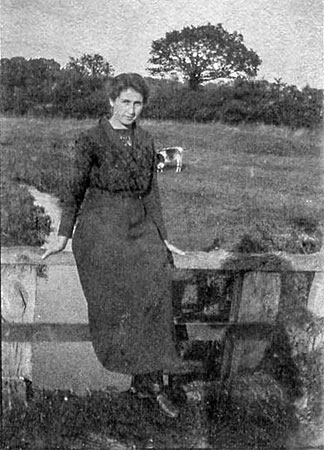 |
Emily Mary Dagless - c.1916 |
Emily Mary Smith at Smokers Hole - c.1930 |
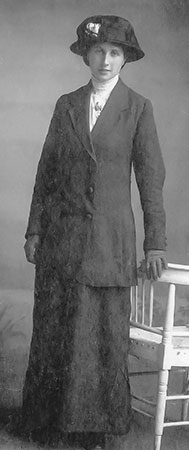 |
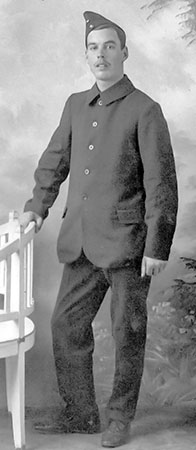 |
Emily Mary Dagless - c.1917 |
Walter Smith - c.1917 |
Walter Smith (1894 - 1971) lived in Baconsthorpe. During WWl he joined the 10th Essex Regiment. It was said that while in a trench on the Somme, a mortar bomb exploded next to him and he was buried alive except for his hand. Luckily someone saw his hand moving and he was rescued but very badly injured in the leg from shrapnel and walked with a limp for the rest of his life. |
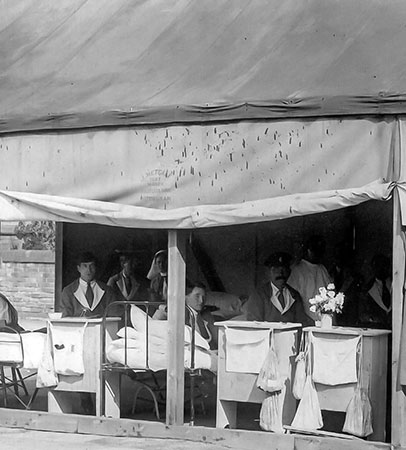 |
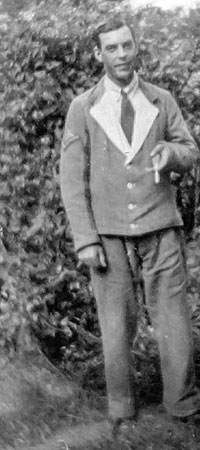 |
Lance Corporal Walter Smith recuperating from his leg injury at West Bridgeford Military Hospital, Nottingham c.1918 |
|
Walter Smith's brother Henry John Smith (1898 - 1917) also lived in Baconsthorpe. During WWl he joined the Duke of Cambridge Own Middlesex Regiment and was killed at Ypres, Flanders in 1917. |
Sarah and James Dagless' daughter Emily Mary married Walter Smith in 1919 and they had seven children - |
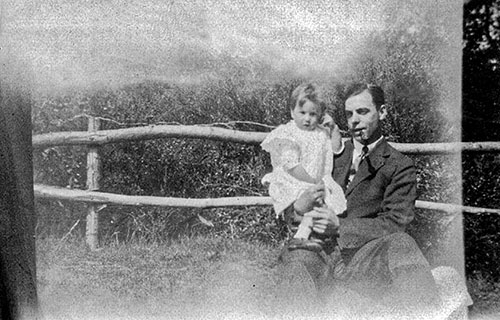 |
 |
Walter Smith with his eldest son Henry, at Smokers Hole - 1920 |
Emily Mary Smith at Smokers Hole - c.1930 |
I believe Walter Smith began as a gardener. After being badly injured in WW1 he was left with a limp as one leg was "dead". He was rehabilitated to do carpentry and I think this is what he mainly did thereafter. He worked on airfields where a lot of building went on for WW2 |
Walter Smith also worked as a carpenter and probably helped with the construction of Matlaske Airfield. After the war he worked at Greshams School in Holt. |
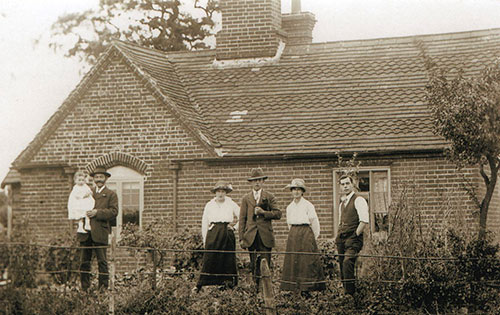 |
Walter Smith's parents' house - The Lodge, Baconsthorpe - c.1922 left to right - Thomas Smith (Walter's father) holding Walter's son Henry, ? lady, ? man, Emily Mary Smith, Walter Smith |
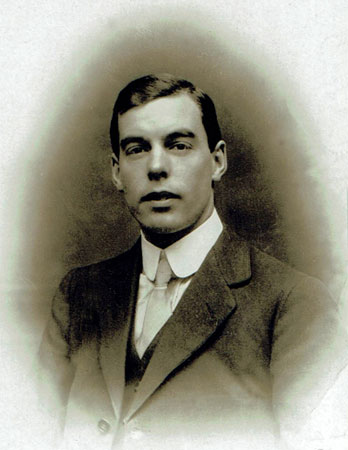 |
Walter Smith - c.1923 |
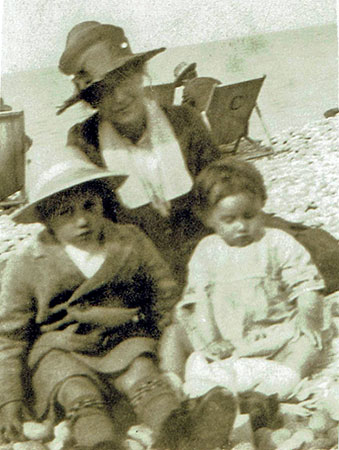 |
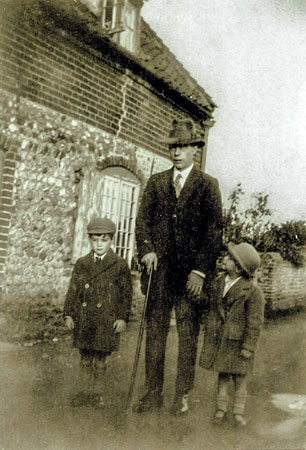 |
Long Sal with Henry and Mattie Smith at Sheringham beach - c.1926 |
Walter Smith with Frederick and Peter at Baconsthorpe - c.1932 |
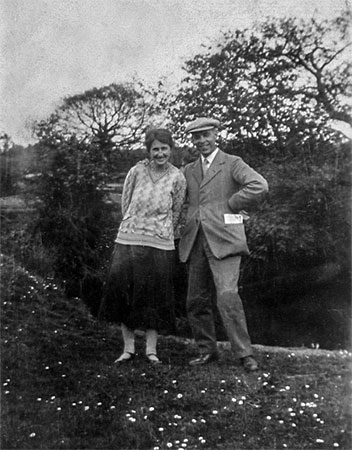 |
Emily Mary Smith (Long Sal's daughter) with husband Walter Smith at Smokers Hole - c.1932 |
Lots of the tales involved 'Granny's old pony'. It had a mind of its own and would sometimes bolt home before Sarah could get into the cart, from Baconsthorpe to Smokers. When she got home by some lift or other it would be waiting at the gate to its field, unable to get through. According to some who drove it, it always turned into The Feathers in Holt! It eventually kicked out the bottom of the cart and a new one was acquired. Eventually the pony was replaced too, and its successor proved just as intractable. Neither of them had a name. |
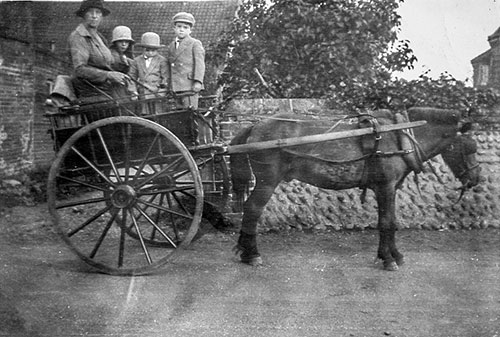 |
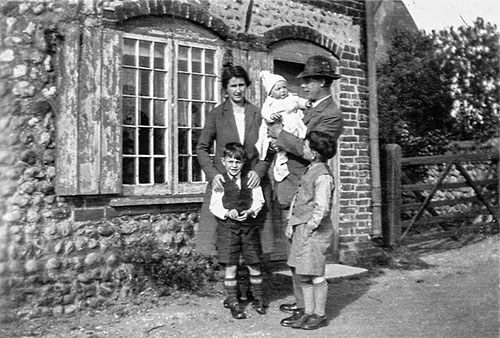 |
Sarah Dagless in Baconsthorpe preparing to go to Sheringham with grandchildren Edith Mary, Peter John and Frederick Walter Smith - c.1932 |
Emily & Walter Smith outside their house in Baconsthorpe with Peter (b.1928) Frederick (b.1926) and young Raymond (b.1932) - 1933 |
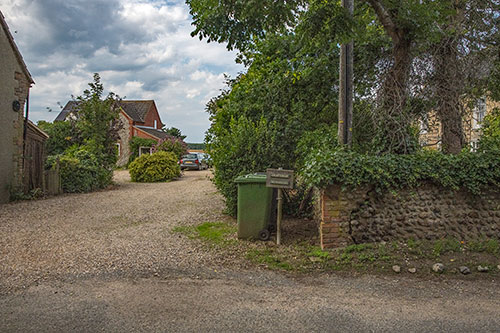 |
Above location - 22nd July 2020 |
In the pony-cart are my father [Frederick] and two of his siblings. They are getting ready to go on a trip to Sheringham. The pony would be taken into the stable at the Robin Hood pub, my father told me. Their grandmother would tell them to stay where they were and go into the pub where they would see her at the bar. |
 |
|
1904 map of Baconsthorpe Street showing where the pony and trap were standing Courtesy of NLS map images
|
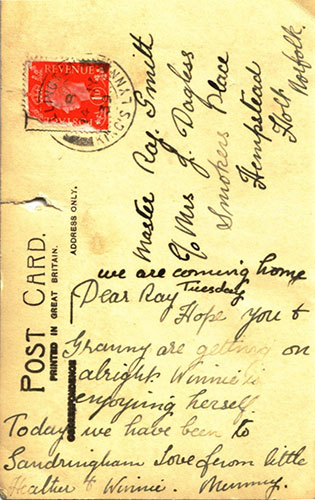 |
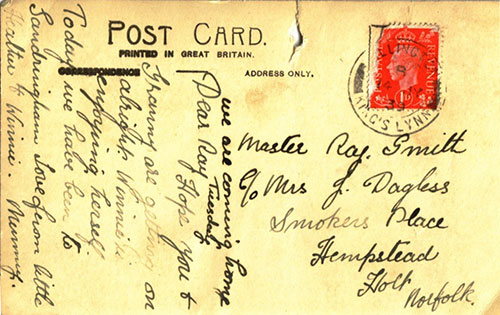 |
Postcard sent by Emily Mary Smith (née Dagless) to her son Ray (James) at Smokers 'Place' - 14th May 1939 |
|
Henry James Smith served in the RAF during WWll and Frederick Walter Smith joined the army and saw active service during the latter stages of the war. |
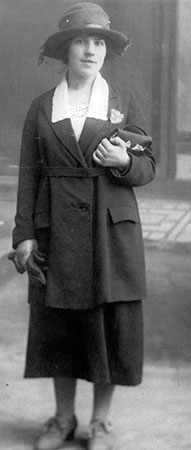 |
Polly Dagless - 1923 |
Sarah's son Arthur Clifford Dagless married Mary Ann Doy in 1925. Arthur Clifford was known as Cliffy and worked as a gamekeeper, living at Keeper's Cottage, Hillington, Norfolk. Mary Ann, known as Polly was born in Holt in 1900 and died in Wellingborough in 1987. |
My Mum said the house wasn't destroyed by the army - it just fell down soon after the war. It was a wonder Long Sally wasn't killed though as she just drove her pony very close to the firing. Teddy Jones lived there after Long Sally. |
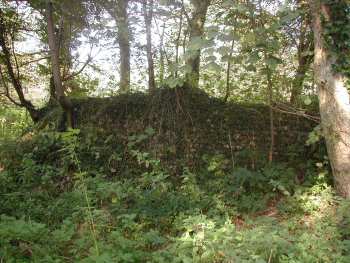 |
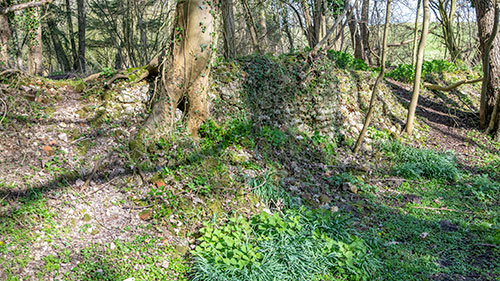 |
One remaining wall of the Mill Cottages 29th Sept 2002 |
21st March 2020 |
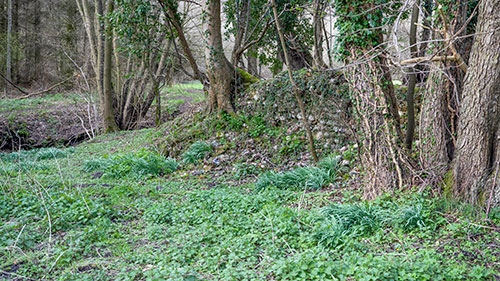 |
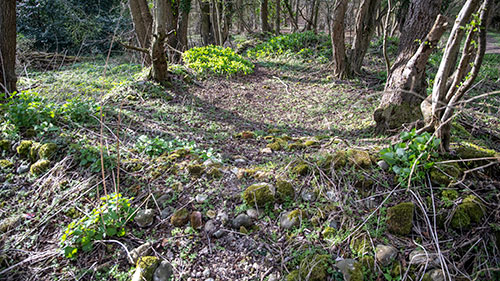 |
Cottages wall with river beyond - 21st March 2020 |
Mill House - later two cottages, interior - 21st March 2020 |
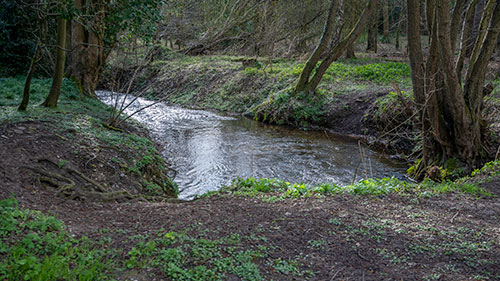 |
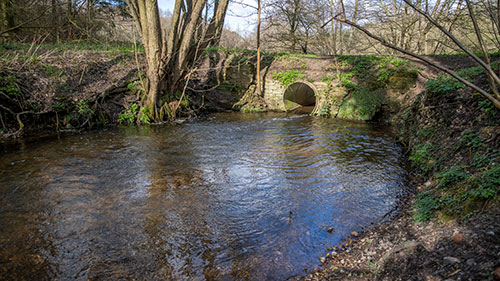 |
Mill race - 21st March 2020 |
Mill remains - 21st March 2020 |
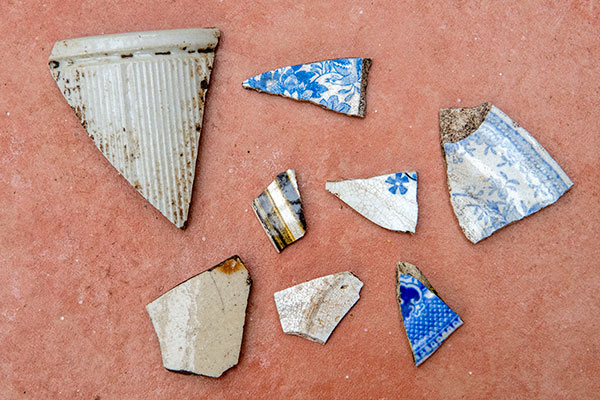 |
Pottery remains found on site - 29th March 2020 |
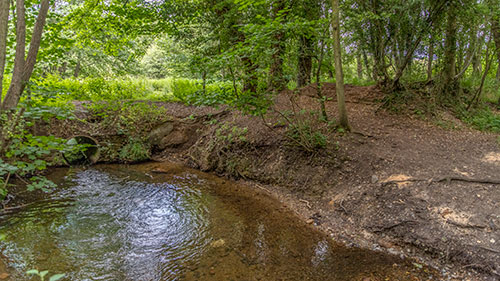 |
Smokers Hole - River Glaven and gable end of Mill Cottages - 24th July 2020 |
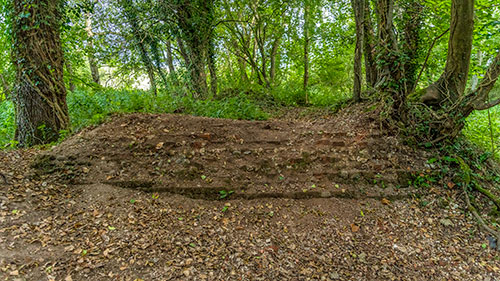 |
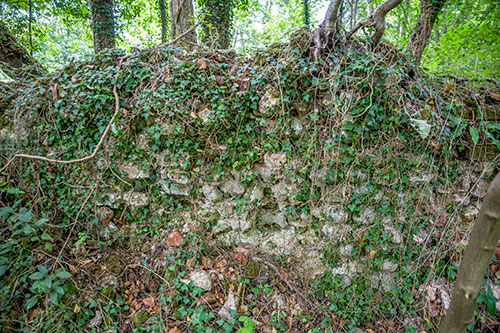 |
Gable end remains of Mill Cottages - 24th July 2020 |
Mill Cottage south wall remains - 24th July 2020 |
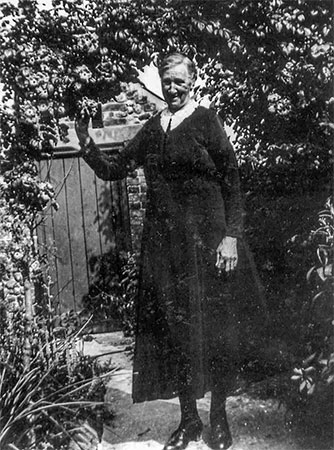 |
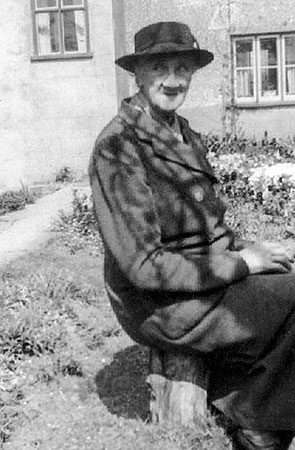 |
Sarah Ann Dagless (Long Sal) in the garden of Walter and Emily Smith's larger house in Baconsthorpe - c.1950 |
Sarah Ann Dagless (Long Sal) in the garden of Walter and Emily Smith's larger house in Baconsthorpe - c.1954 |
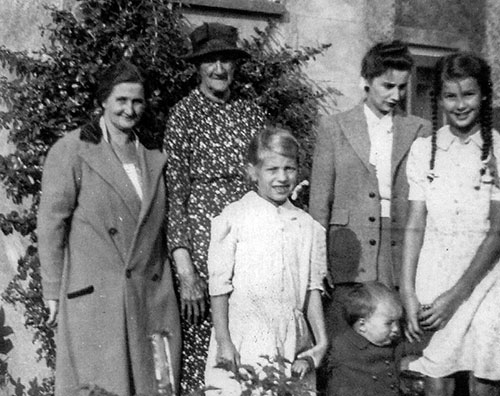 |
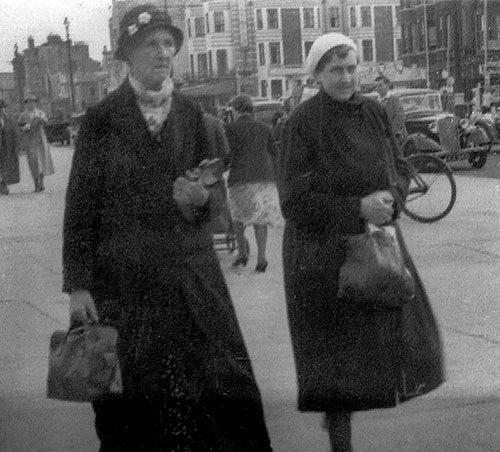 |
left-right back Emily Mary Dagless, Sarah Ann Dagless, Edith Mary Melvin née Smith left-right front Heather Smith, John Melvin (1946-2012), Winne Smith Outside Emily House - 1947 |
Sarah Ann and half sister May in Gt Yarmouth - c.1952 |
When my husband was about 4, he remembers that he and his twin brother went with their mother (Edith Mary Melvin) every morning to Long Sal's council bungalow with an electric kettle as, she didn't have one. Their mother made her tea and gave her breakfast. Then one morning she told the two boys to wait outside, because Long Sal had died! |
My mother told me she had suddenly remembered very vividly seeing Sarah in her coffin! In the days before the funeral the coffin was laid in my grandparents' (Emily and Walter) front room and my grandmother assumed my mother would like to view her dead mother and remarked how lovely and peaceful she looked but my mother thought she just looked dead. She was not struck by the coffin looking extra long, apparently. |
My gt grandmother, Blanch Dagless lived at Great Yard, Saxthorpe and she told my mother that there was a big turnout for Long Sal's funeral and a special long coffin was made for her. |
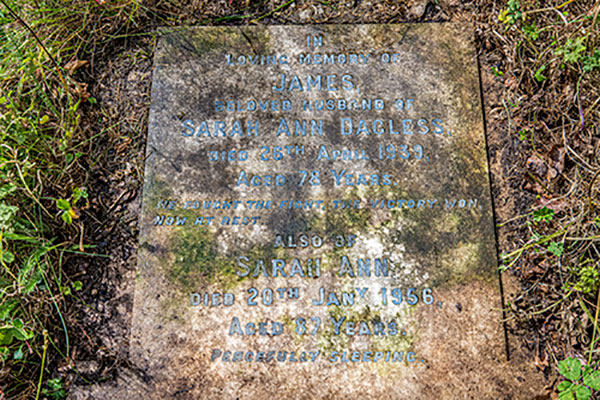 |
Grave of James & Sarah Ann (Long Sal) Dagless in Edgefield Churchyard 10th July 2020 |
IN |
I only remember seeing Long Sally once. She was with another woman in her (Sally’s) pony trap coming up the Loke beside Church Farm from Smoker’s Hole. |
Emily and Walters' house is opposite the junction where a road goes up in the direction of the old hall/castle. [Baconsthorpe Castle] It had no name when they lived there but the people who bought it afterwards called it Emily House after my grandmother. Behind there was a large garden, an orchard, a meadow and a yard surrounded by outbuildings; huge barn and carpenters' shop with loft, stable, and much much more (though when I first knew it there was still no indoor toilet). It was built by a builder. He left his accounts book behind which made fascinating reading. It was a big step up for the family when they moved from what was always referred to as the "little house" to the big house. |
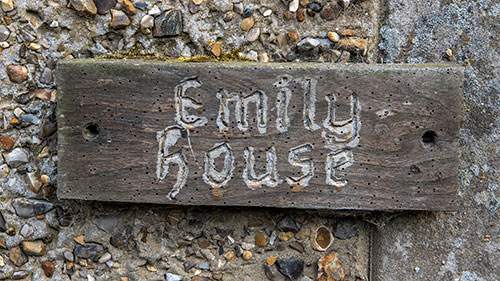 |
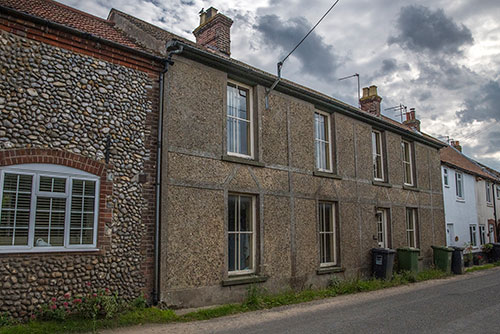 |
Emily House - 22nd July 2020
|
|
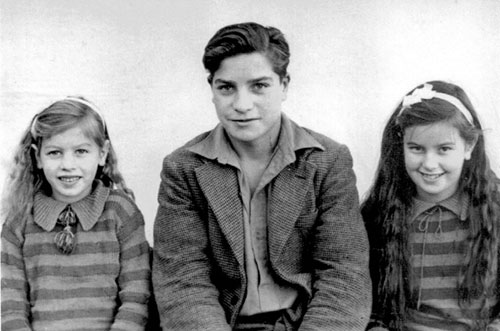 |
Heather. Jimmy (Ray) and Winnie Smith c.1945 |
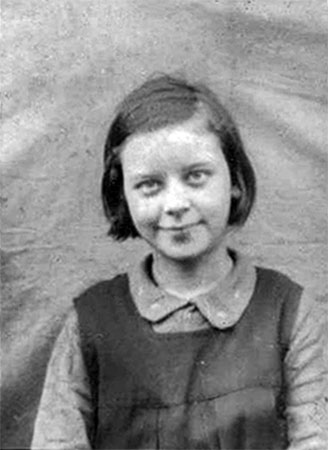 |
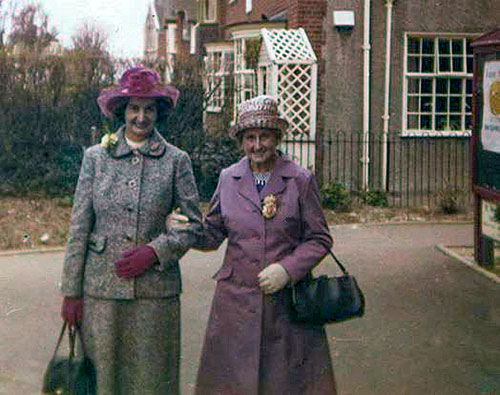 |
Edith Mary (Matty) Smith - c.1933 |
Edith Mary Smith (1924-1984) with mother Emily Mary Smith (1895-1982 1975 |
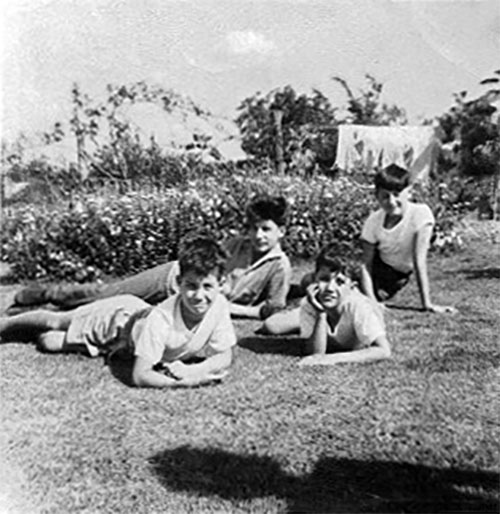 |
Edith Mary Melvin (née Smith)'s sons at Emily House, Baconsthorpe c.1960 |
The above photo was taken in Emily and Walter Smith's garden at Baconsthorpe, in about 1960. They are Long Sal's great grandsons, the Melvin boys. At the back John (left) and Peter (right) the twins Tom and Charlie at the front. Grannie Smith always called them both TommyCharlie as they were identical. My husband is one of the twins, but not sure which! |
I have a family connection with Long Sal. She was stepmother to my great grandmother Thirza Amelia Dagless. |
Long Sal and James Dagless are the great grandparents of my husband, Tom Melvin. James Dagless had a lot of children with his first wife Harriet Chapman and then Sarah Ann Rice (Long Sal). There are a lot of their descendants still in Norfolk. |
31st October 1868: Sarah Ann Rice born
c.1943: Sarah Dagless left Smokers Hole on orders from the army, to live in Baconsthorpe |
If you have any memories, anecdotes or photos please let us know and we may be able to use them to update the site. By all means telephone 07836 675369 or
|
Copyright © Jonathan Neville 2020 |